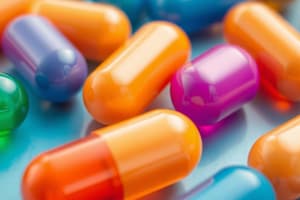Podcast
Questions and Answers
Who invented the soft gelatin capsule?
Who invented the soft gelatin capsule?
- Mothes (correct)
- Stearate
- Murdock
- Lauryl
What is the advantage of filling capsules with liquids rather than powders?
What is the advantage of filling capsules with liquids rather than powders?
- Improved bioavailability (correct)
- Reduced cost
- Easier administration
- Increased mechanical strength
How is the size of the capsule required for the formulation determined?
How is the size of the capsule required for the formulation determined?
- By the weight of the API
- By the volume of the capsule
- By the moisture content of the granules
- By the tapped bulk density and capsule volume (correct)
What is the purpose of a glidant in a capsule formulation?
What is the purpose of a glidant in a capsule formulation?
What is the process of producing pellets?
What is the process of producing pellets?
What is the role of sodium lauryl sulfate in a capsule formulation?
What is the role of sodium lauryl sulfate in a capsule formulation?
What is the primary function of a spheroniser in pharmaceutical manufacturing?
What is the primary function of a spheroniser in pharmaceutical manufacturing?
Which of the following is an example of a capsule-filled pellet formulation?
Which of the following is an example of a capsule-filled pellet formulation?
What is the primary purpose of a capsule filling equipment?
What is the primary purpose of a capsule filling equipment?
What is the main difference between SGCs and HGCs in terms of gelatine formation?
What is the main difference between SGCs and HGCs in terms of gelatine formation?
What is the most widely used method of sealing capsules?
What is the most widely used method of sealing capsules?
What is the advantage of SGCs over HGCs and tablets in terms of patient compliance?
What is the advantage of SGCs over HGCs and tablets in terms of patient compliance?
Flashcards are hidden until you start studying
Study Notes
Invention and History
- The soft gelatin capsule was invented by Mothes, a French pharmacist, in 1833.
- Murdock patented the two-piece hard gelatin capsule in 1848.
Capsule Characteristics
- Capsules are solid dosage forms that contain a drug substance enclosed in a hard or soft, soluble container or shell of gelatin or other suitable material.
- Gelatin capsules are available as hard (HGC) and soft (SGC) capsules.
Advantages of HGC and SGC
- Improve patient compliance
- Enhance attractiveness (psychological advantages)
- Easy to administer, as the capsules become slippery when moist
- Mechanically strong but flexible
- Bioavailability may be further increased by filling capsules with liquids rather than powders
Hard Gelatin Capsules (HGC)
- Available in 8 sizes, ranging from 5 to 000, with larger ones available for veterinary products
- Capsule size required for formulation is determined by Caps Fill Wt = tapped bulk density X caps vol
Filling Materials
- Typical formulation consists of:
- API
- Diluent (Maize starch and lactose)
- Wetting agent (sodium lauryl sulfate)
- Glidant (talc or fumed silicon dioxide)
- Lubricant (magnesium stearate)
Pellet Production Process
- Extrusion: wet mass through a metal screen to produce rod-shaped particles of uniform diameter
- Spheronization: to form extrudate into spheroids of uniform size
- Spheroniser: a bowl with fixed sides and a rotating bottom plate (or disc) to round particles
Examples of Capsule Formulations
- Capsules filled with coated granules: Venlafaxine HCL (Extended Release)
- Capsules filled with pellets: Morphine Sulfate (Extended-release product)
- Capsules filled with powders: Celecoxib (Celebrex) NSAID
Capsule Filling Equipment
- 4 types of equipment with different principles, all allowing:
- Positioning of capsules
- Separation of 2 halves
- Filling with formulation
- Refitting and locking of 2 halves
Sealing Methods
- Spot Welding: hot probe used to weld 2 halves of capsule shell together
- Banding: a band of molten gelatin forms round the joint between the 2 halves
- Locking: most widely used method
Soft Gelatin Capsules (SGC)
- More appealing dosage form than HGCs or tablets, with greater bioavailability
- May reduce dose required and size of capsule required, increasing patient compliance
- Produced using special types of encapsulation machines for lipophilic liquids, such as:
- Globlex method
- Rotary die method
Studying That Suits You
Use AI to generate personalized quizzes and flashcards to suit your learning preferences.




